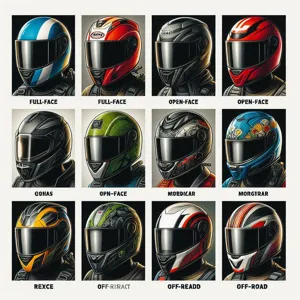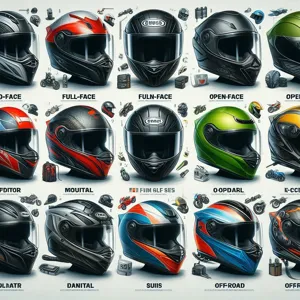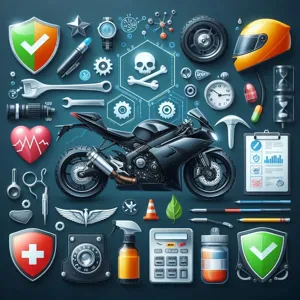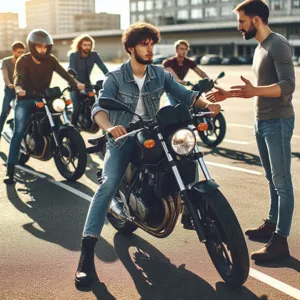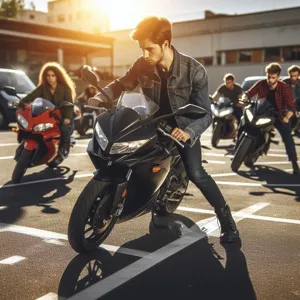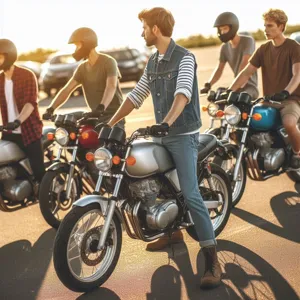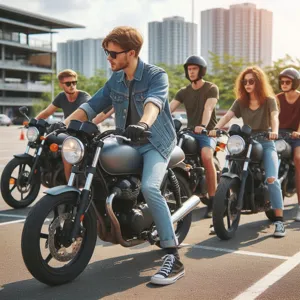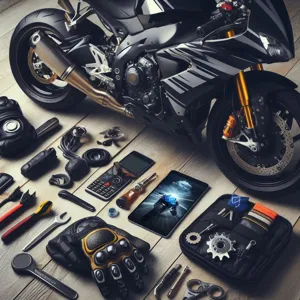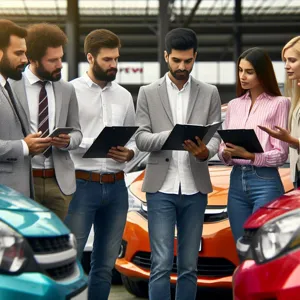When it comes to hitting the open road on two wheels, the right gear can make all the difference between an exhilarating ride and a potentially dangerous situation.
Among the essential pieces of motorcycle equipment, a quality motorbike jacket stands out as a key element in ensuring your safety and comfort. With a multitude of options available—ranging from rugged leather styles to high-tech textile designs—finding the perfect jacket that balances protection and comfort can feel overwhelming. In this ultimate guide, we’ll navigate through the crucial features and factors to consider, such as material durability, fit, weather resistance, and protective armor. Whether you’re a seasoned rider or just starting your journey into the world of motorcycling, this comprehensive guide will equip you with the knowledge needed to choose a motorbike jacket that not only looks great but also provides maximum protection as you conquer new horizons. Get ready to ride with confidence!
1. Introduction: Why the Right Motorbike Jacket Matters

When it comes to motorcycling, safety and comfort should always be top priorities for every rider. The right motorbike jacket is not just an accessory; it’s a crucial piece of gear that can significantly influence your riding experience. Imagine cruising down winding roads, the wind rushing past you, and the thrill of the ride coursing through your veins. Now, picture doing so without the right protection. The risks associated with motorcycling are real, making the choice of a suitable jacket all the more important.
A well-fitted motorbike jacket does more than just provide a layer of protection against the elements; it serves as your first line of defense in case of an accident. It’s designed to absorb impact and reduce abrasions, safeguarding your skin against the harsh reality of the asphalt. Whether you’re a seasoned rider or a newcomer to the biking world, understanding the significance of this piece of gear is vital.
Beyond safety, comfort is equally essential. The right jacket can enhance your overall riding experience, allowing for greater freedom of movement and reducing fatigue on longer journeys. With an array of materials, styles, and features available, the options can be overwhelming. But fear not; this guide will help you navigate through the myriad choices, ensuring you find a jacket that not only meets safety standards but also matches your personal style and fits like a glove.
So, why does the right motorbike jacket matter? It’s simple: it’s about protecting your body while ensuring you enjoy every exhilarating moment spent on your bike. Let’s dive deeper into what makes a motorbike jacket the perfect companion for your rides.
2. Understanding Different Types of Motorbike Jackets
When it comes to selecting the perfect motorbike jacket, understanding the various types available is essential for ensuring both protection and comfort on the road. Each style is designed with specific riding conditions and preferences in mind, making it crucial to choose one that aligns with your needs.
**1. Leather Jackets:** Renowned for their durability and classic aesthetic, leather jackets are a favorite among many riders. They offer excellent abrasion resistance and can withstand the elements. While they may feel stiff at first, quality leather jackets break in beautifully over time, forming to your body for a personalized fit. Additionally, many modern leather jackets come equipped with armor in key impact areas, enhancing your protection without sacrificing style.
**2. Textile Jackets:** Made from synthetic materials like nylon or polyester, textile jackets are often lighter and more versatile than their leather counterparts. They are typically designed with waterproof and breathable membranes, making them ideal for varying weather conditions. Many textile jackets also feature removable liners, allowing for greater adaptability across seasons. The inclusion of armor and reflective materials adds to their safety features, making them a popular choice for everyday riders.
**3. Adventure Jackets:** For those who venture off the beaten path, adventure jackets merge the best of both leather and textile into one robust package. Featuring a rugged exterior, ample storage, and ventilation systems, these jackets are built for long journeys and changing environments. With reinforced padding and specialized armor, adventure jackets provide enhanced protection against both impact and the elements, making them perfect for dual-sport and touring enthusiasts.
**4. Racing Jackets:** If speed is your passion, racing jackets are designed to offer maximum protection at high velocities. Often made from high-quality leather or advanced textiles, these jackets are equipped with features such as aerodynamic profiles, built-in armor, and stretch panels for better mobility. The snug fit not only enhances safety by keeping the jacket in place during a ride but also improves comfort by minimizing wind resistance.
**5. Cruiser Jackets:** Embracing a more relaxed style, cruiser jackets are perfect for those who enjoy leisurely rides. They often feature a looser fit, providing comfort during long hours in the saddle. Made from both leather and textiles, cruiser jackets can come with various embellishments, from studs to embroidery, allowing riders to express their personality while still prioritizing protection.
As you navigate through the various options, consider your riding style, the conditions you’ll encounter, and your personal preferences. A well-chosen motorbike jacket not only enhances your comfort but also serves as a critical layer of protection, making it an investment worth careful consideration.
3. Key Features to Look for in a Motorbike Jacket

When it comes to selecting the ideal motorbike jacket, understanding the key features that contribute to both protection and comfort is essential. A well-designed jacket not only enhances your riding experience but also safeguards you against the unexpected elements on the road.
**1. Material Composition**: The fabric of your jacket plays a pivotal role in its protective capabilities. Look for jackets made from durable materials like cowhide leather, Cordura, or textile blends that offer abrasion resistance. Leather is renowned for its toughness, while high-tech textiles can provide excellent waterproofing and breathability, striking a balance between protection and comfort.
**2. Armor and Padding**: A quality motorbike jacket should come equipped with CE-approved armor at critical impact zones, such as the shoulders, elbows, and back. This armor absorbs shock during a fall, significantly reducing the risk of injury. Additionally, consider jackets with removable or adjustable padding that allows you to personalize your fit and protection level.
**3. Fit and Comfort**: Comfort is key for long rides, so look for a jacket that fits snugly without being restrictive. Features like adjustable cuffs, waistbands, and ventilation zippers can enhance comfort and allow for a customizable fit. Remember that a jacket that feels great while standing may not offer the same comfort while riding, so try it on in a riding position if possible.
**4. Weather Resistance**: Depending on your riding environment, weather resistance can be a critical feature. Look for jackets with waterproof or water-resistant linings, as well as thermal insulation for colder climates. Ventilation systems, such as zippered air vents, can help regulate temperature during warmer rides, ensuring you stay comfortable regardless of the weather conditions.
**5. Visibility**: Safety extends beyond protection during a fall; being seen on the road is equally important. Choose a jacket with reflective panels or bright colors to increase your visibility to other drivers, especially during low-light conditions. This simple yet effective feature can enhance your safety significantly.
**6. Storage**: Practicality should not be overlooked. A good motorbike jacket will have ample pocket space for your essentials—think secure compartments for your phone, wallet, and keys. Some jackets even come with internal pockets for added security, allowing you to ride hands-free without worrying about losing your belongings.
By keeping these key features in mind, you’ll be well on your way to choosing a motorbike jacket that not only offers maximum protection and comfort but also complements your personal style. Investing in the right jacket is an essential step toward enjoying every ride with confidence and peace of mind.
4. Material Matters: Leather vs. Textile vs. Hybrid
When it comes to selecting the right motorbike jacket, the material you choose can significantly impact both your protection on the road and your overall comfort during rides. Understanding the pros and cons of leather, textile, and hybrid jackets can help you make an informed decision that aligns with your riding style and personal preferences.
**Leather Jackets**: Often regarded as the quintessential choice for bikers, leather jackets offer unparalleled durability and abrasion resistance. The thick, tough exterior of leather can provide excellent protection in the event of a fall, making it a favorite among enthusiasts who prioritize safety. Additionally, leather jackets often feature a timeless aesthetic, exuding a classic, rugged vibe that many riders appreciate. However, they can be heavy and less breathable, which may lead to discomfort in warmer climates. It’s also worth noting that leather requires proper care and maintenance to preserve its quality over time.
**Textile Jackets**: For those seeking versatility and comfort, textile jackets present an appealing alternative. Typically made from synthetic materials like nylon or polyester, these jackets are often lighter and more breathable than their leather counterparts. Many textile jackets come equipped with waterproof membranes, making them a practical choice for riders who face unpredictable weather conditions. Additionally, they often feature multiple ventilation options, ensuring that you stay cool during summer rides. However, while textile jackets provide decent protection, they may not offer the same level of abrasion resistance as leather.
**Hybrid Jackets**: If you’re looking for the best of both worlds, hybrid jackets combine the strengths of leather and textile materials. These jackets often feature a leather exterior for the arms and shoulders—areas that experience the most wear during a fall—while utilizing lighter, more breathable textile panels for the body. This design allows for superior protection where it’s needed most, while keeping you comfortable and flexible. Hybrid jackets are particularly appealing for riders who want to enjoy the durability of leather without sacrificing the comfort and breathability of textiles.
In summary, when choosing between leather, textile, and hybrid jackets, consider factors such as your typical riding conditions, preferred style, and how much protection you need. Each material has its unique advantages, and understanding these differences can help you select a jacket that not only safeguards you on the road but also enhances your riding experience with optimal comfort.
5. The Importance of Fit: Finding Your Perfect Size

When it comes to choosing the perfect motorbike jacket, fit is paramount. A jacket that is too loose can flap in the wind, creating distractions and potentially compromising your safety, while one that is too tight may restrict your movement, hindering your ability to maneuver your bike effectively. Achieving the ideal fit ensures not only your comfort during long rides but also enhances the protective capabilities of the jacket.
To find your perfect size, start by measuring key areas of your body, including your chest, waist, and arms. Most manufacturers provide a sizing chart that correlates these measurements with specific sizes, making it easier for you to choose wisely. Pay special attention to the jacket’s silhouette—whether it’s a sport cut or a classic fit—as this can significantly impact how it feels while riding.
Once you have a jacket in mind, try it on with your riding gear to simulate the real experience. Make sure to check for any constriction when reaching for the handlebars or turning your head. Additionally, look for adjustments such as straps or zippers that allow you to customize the fit to your body shape.
Remember, the right jacket should provide a snug fit without being restrictive, allowing for ease of movement while still keeping you protected. Investing time in finding that perfect fit will not only enhance your riding experience but also ensure that you stay safe on the road. After all, a jacket is not just an accessory; it’s a crucial element of your riding gear that plays a vital role in your overall safety and comfort.
6. Armor and Protection: What You Need to Know
When it comes to selecting a motorbike jacket, the armor and protection it offers should be at the forefront of your decision-making process. Riding a motorbike exposes you to various hazards, and a well-fitted jacket with the right protective features can be your first line of defense against potential injuries.
Start by examining the type of armor integrated into the jacket. Look for jackets equipped with CE-certified armor, which is designed to absorb impact and minimize injury during a fall. The most commonly protected areas include the shoulders, elbows, and back. Some jackets even come with additional padding for the chest, providing extra protection where it’s needed most. It’s essential that this armor is not only present but also removable and adjustable so that you can customize the fit according to your comfort.
The material of the jacket plays a significant role in its protective capabilities as well. High-quality leather or advanced synthetic fabrics such as Cordura are excellent choices as they offer superior abrasion resistance. Many modern jackets also feature reinforced stitching and additional layers in high-impact areas to bolster durability.
Another key consideration is the jacket’s design for airflow and ventilation. While it’s crucial to have robust protection, you don’t want to compromise on comfort, especially during long rides in various weather conditions. Look for jackets that include ventilation zippers or mesh panels that allow for airflow while maintaining armor integrity.
Lastly, ensure the jacket fits snugly but allows for a full range of motion. An ill-fitting jacket not only diminishes protection but can also distract you while riding. Take the time to try on different styles and sizes, keeping in mind that the jacket may need to fit comfortably over other layers of clothing.
In summary, when selecting a motorbike jacket, prioritize armor quality, material strength, ventilation, and fit to ensure maximum protection and comfort. Your jacket is more than just a fashion statement; it’s an essential piece of gear that can significantly impact your safety on the road.
7. Weather Considerations: Choosing for All Conditions

When it comes to selecting the perfect motorbike jacket, one of the most crucial factors is how well it performs in varying weather conditions. Whether you’re cruising through sun-drenched highways or navigating rainy backroads, your jacket should provide the right balance of protection and comfort tailored to the climate you’ll be riding in.
In sunny weather, look for jackets made from lightweight and breathable materials, such as mesh or perforated leather. These fabrics allow air to circulate, keeping you cool even during long rides. Features like removable liners can also enhance comfort, enabling you to adapt your jacket to the changing temperatures throughout the day. Additionally, reflective strips can help increase your visibility during those bright, sunny rides when the glare can be particularly blinding.
Conversely, when the skies turn grey and rain starts to fall, having a waterproof or water-resistant jacket is essential. Look for jackets with sealed seams and waterproof membranes to keep you dry during unexpected downpours. A good motorbike jacket should also have ventilation options that can be closed off to retain warmth, ensuring you stay comfortable even in the chill of the rain.
If you frequently ride in colder conditions, opt for jackets with thermal liners or insulated options that trap heat without adding excessive bulk. Wind-resistant materials can also make a significant difference in keeping you warm and protected from biting winds on those brisk rides.
Ultimately, the key to a successful ride in any weather is versatility. Consider jackets that offer adjustable features, such as removable liners, vents, and cuffs. This flexibility allows you to tailor the jacket to suit the conditions, ensuring that whether you face blistering heat or torrential rain, you’ll remain comfortable and protected. By thoughtfully considering weather conditions and selecting a jacket that meets those demands, you can enhance your riding experience and ride with confidence, no matter what Mother Nature throws your way.
8. Style vs. Functionality: Balancing Aesthetics and Safety
When it comes to choosing the perfect motorbike jacket, one of the most significant dilemmas riders face is the balance between style and functionality. While aesthetics play a crucial role in making a statement on the road, it’s essential not to overlook the jacket’s protective features. After all, a motorbike jacket is not just a fashion accessory; it’s your first line of defense against the elements and potential accidents.
In today’s market, motorbike jackets come in a myriad of styles, ranging from sleek, modern designs to classic, rugged looks. You might be drawn to the allure of a vintage leather jacket, with its timeless appeal and patina that exudes character. However, it’s vital to ensure that it offers the necessary armor and abrasion resistance. On the flip side, a high-tech jacket made from advanced synthetic materials may boast impressive safety features, but if it doesn’t resonate with your personal style, it can leave you feeling less confident on your ride.
Finding the right balance involves considering both the protective elements and your personal aesthetic preferences. Look for jackets that incorporate safety features such as CE-rated armor in the shoulders, elbows, and back, as well as reflective materials to enhance visibility. Brands are increasingly offering jackets that combine stylish designs with cutting-edge protective technologies, ensuring you don’t have to compromise on either front.
Moreover, think about the versatility of your jacket. A good motorbike jacket should not only look great while riding but also be suitable for off-bike wear. Opt for styles that allow you to transition seamlessly from the road to a casual outing with friends. With thoughtful design, many jackets now feature removable liners, adjustable ventilation, and stylish cuts that enhance both comfort and safety.
Ultimately, your motorbike jacket should embody your personality while prioritizing your safety on the road. By carefully evaluating your options and seeking a jacket that marries style with functionality, you can ride confidently, knowing you look good and are protected.
9. Breathability and Comfort: Staying Cool on Rides
When it comes to choosing the perfect motorbike jacket, breathability and comfort are essential factors that can significantly enhance your riding experience. As any seasoned rider knows, long hours on the road can lead to discomfort if your gear isn’t designed with airflow in mind. Riding can be exhilarating, but without adequate ventilation, it can quickly turn into a sweaty ordeal, especially during the hotter months or on long trips.
Look for jackets crafted from materials that promote airflow, such as mesh fabrics or those with strategically placed ventilation panels. These features allow air to circulate, keeping your body cool while you ride. A well-ventilated jacket not only helps regulate your temperature but also minimizes the buildup of moisture, ensuring you stay comfortable even on the longest journeys.
Additionally, consider the jacket’s design and fit. A jacket that is too tight can restrict movement, leading to discomfort and fatigue, while one that is too loose may flap in the wind, creating drag. A well-fitted jacket will provide both protection and comfort, allowing you to maneuver your bike with ease. Look for adjustable features, such as cuffs and waistbands, that enable you to customize the fit to your liking.
Moreover, many modern motorbike jackets come equipped with removable liners that can offer extra insulation during cooler rides. These versatile jackets can adapt to changing weather conditions, ensuring that you remain comfortable whether it’s a brisk morning ride or a sunny afternoon adventure.
Ultimately, a motorbike jacket that emphasizes breathability and comfort not only enhances your riding experience but also encourages you to ride more often. Prioritizing these features will make your time on the road not only safer but also more enjoyable, allowing you to focus on the thrill of the ride rather than the discomfort of your gear.
10. Reflective Gear: Enhancing Visibility on the Road
When it comes to motorbike safety, visibility is paramount, especially during low-light conditions or inclement weather. This is where reflective gear plays a crucial role in enhancing your presence on the road. Reflective gear, often integrated into the design of motorbike jackets, is made from materials that bounce back light, making you more visible to other road users, including cars and pedestrians.
Imagine riding at dusk, the sun dipping below the horizon, casting long shadows on the road. As you navigate through traffic, a jacket with strategically placed reflective strips catches the headlights of passing vehicles, alerting drivers to your presence. This simple yet effective feature can be the difference between a close call and a tragic accident.
When selecting a motorbike jacket, look for options that incorporate high-quality reflective materials. These should not only cover large areas of the jacket but also be designed in a way that maximizes visibility from multiple angles. Some jackets feature reflective piping along the seams, while others offer larger patches that glow brightly when illuminated. The key is to find a balance between style and safety; a jacket that looks great during the day should still be functional in low-light conditions.
Moreover, consider how the reflective elements blend into the overall design of the jacket. Many manufacturers now offer sleek, modern aesthetics that incorporate reflective materials without compromising on style. This means you can ride confidently, knowing you’re protected and seen, whether you’re commuting during rush hour or enjoying a weekend adventure.
Ultimately, investing in a motorbike jacket with reflective gear is not just about compliance; it’s about taking proactive steps to ensure your safety on the road. By enhancing your visibility, you not only protect yourself but also contribute to a safer riding environment for everyone. So, when choosing your jacket, prioritize reflective features that will keep you visible and keep your rides safe.
11. Budgeting for Quality: What to Expect at Different Price Points
When it comes to motorbike jackets, the price tag often reflects the quality, materials, and protective features you can expect. Understanding what you can anticipate at various price points is essential for making an informed decision that balances both safety and your budget.
**Under $100:** At this entry-level price, you can find basic jackets that may offer some level of protection but are likely made from lower-quality materials. These jackets might feature minimal armor and limited weather resistance. While they can be suitable for casual riders or short trips around town, they may not withstand the rigors of a serious ride or a crash.
**$100 to $300:** In this mid-range category, you’ll start to see improvements in both quality and protection. Jackets in this price range often utilize better materials like reinforced textiles and may include CE-rated armor in the shoulders and elbows. Additionally, features such as improved ventilation, waterproof linings, and reflective elements for visibility become more common. This price bracket is ideal for everyday riders who want a balance of comfort, functionality, and safety without breaking the bank.
**$300 to $600:** As you move into this higher price range, expect a significant upgrade in construction and features. Jackets will likely be crafted from high-quality leather or advanced synthetic fabrics that provide excellent abrasion resistance. You’ll find comprehensive armor coverage, including back protectors, and enhanced ergonomic designs that allow for better mobility on the bike. Additionally, many jackets will come with advanced weatherproofing technology, ensuring you stay dry and comfortable in varying conditions. This range caters to serious riders who prioritize safety and durability.
**Above $600:** At this premium level, you’re investing in top-tier motorbike jackets that offer the highest level of protection and comfort. Expect to see jackets made from the finest materials, such as full-grain leather or advanced textile blends that are both lightweight and resistant to the elements. These jackets often incorporate cutting-edge safety features, like impact-absorbing technology and additional armor pockets for customizable protection. custom fits and aesthetic options abound, appealing to riders who want both style and substance. For those who ride frequently or partake in long-distance touring, this investment can pay off in enhanced safety and comfort on the road.
When budgeting for a motorbike jacket, it’s crucial to weigh the risks versus the benefits. Remember that a higher price often correlates with better protection, comfort, and durability. Investing in a quality jacket is not just a purchase; it’s a commitment to your safety and enjoyment on every ride.
12. Top Brands and Their Best Motorbike Jackets
When it comes to selecting the perfect motorbike jacket, the brand can significantly influence both quality and performance. Renowned brands have spent years perfecting their designs, materials, and technologies to ensure riders receive the utmost protection and comfort. Here’s a closer look at some top brands in the motorbike jacket market and their standout offerings that cater to various riding styles and conditions.
**1. Alpinestars:** Known for their innovative designs and high-performance gear, Alpinestars jackets are a favorite among sportbike enthusiasts. The **Alpinestars GP Pro R3 Jacket** combines a sleek, aerodynamic fit with premium cowhide leather for durability. Equipped with CE-certified protectors and strategically placed ventilation, it ensures riders stay cool without compromising on safety.
**2. Dainese:** A staple in the motorcycling world, Dainese jackets are synonymous with style and protection. The **Dainese Super Rider D3O Jacket** features advanced D3O armor, which offers excellent impact protection while remaining flexible and comfortable. Its sporty silhouette and high-quality materials make it a top choice for those seeking both aesthetics and performance.
**3. REV’IT!:** REV’IT! is acclaimed for its blend of cutting-edge technology and stylish designs. The **REV’IT! Eclipse Jacket** is perfect for warm-weather riding, crafted from lightweight mesh and abrasion-resistant materials. It provides airflow while still housing removable CE-level armor, making it a versatile option for both city commutes and longer rides.
**4. ICON:** If you’re looking for something edgy and bold, ICON has you covered. The **ICON Motorhead Leather Jacket** epitomizes a classic biker style, crafted from premium cowhide leather with a comfortable fit. This jacket not only looks great but also offers ample protection with its CE-rated armor and reinforced impact zones.
**5. Klim:** For adventure riders, Klim is the go-to brand, especially in rugged conditions. The **Klim Badlands Pro Jacket** is built for durability and functionality, featuring Gore-Tex technology for waterproofing and breathability. With multiple pockets and ventilation options, this jacket stands up to the elements while keeping riders comfortable on their longest journeys.
Choosing the right motorbike jacket from these top brands ensures not only style but also the level of protection necessary for safe riding. Whether you’re hitting the open road, navigating city streets, or tackling off-road trails, investing in a quality jacket tailored to your needs is vital for both comfort and safety.
13. Care and Maintenance Tips for Your Jacket
Investing in a quality motorbike jacket is just the first step in ensuring you get the maximum protection and comfort from it. Regular care and maintenance are crucial for prolonging the lifespan of your jacket and maintaining its protective qualities. Here are some essential tips to keep your jacket in top-notch condition.
**1. Clean Regularly:** Depending on your riding frequency and the conditions you face, dirt, grime, and road salt can accumulate on your jacket. For leather jackets, use a damp cloth to wipe off surface dirt, and for textile jackets, follow the manufacturer’s instructions for machine or hand washing. Always use mild detergents specifically designed for motorcycle gear to avoid damaging the fabric.
**2. Dry Properly:** After cleaning, ensure your jacket is dried correctly. For leather jackets, avoid direct sunlight and heat sources, which can cause the material to crack. Instead, let it air dry in a cool, shaded area. For textile jackets, follow the care label to ensure you retain their shape and functionality.
**3. Condition Leather:** If you own a leather jacket, regular conditioning is essential to keep the material supple and water-resistant. Invest in a quality leather conditioner and apply it according to the manufacturer’s instructions, typically every few months or after exposure to harsh weather conditions.
**4. Check for Damage:** Regularly inspect your jacket for any signs of wear and tear, especially after long rides. Pay close attention to zippers, seams, and armor pockets. If you notice any damage, repair it promptly to ensure your jacket continues to provide adequate protection.
**5. Store Wisely:** When not in use, store your jacket in a cool, dry place away from direct sunlight to prevent fading and degradation of materials. Hanging your jacket on a wide hanger can help maintain its shape, but avoid using wire hangers, which can cause creases and deformities.
**6. Waterproofing Treatments:** If your jacket is designed for wet weather, consider reapplying waterproofing treatments periodically. Many textile jackets have a durable water repellent (DWR) coating that can wear off over time. Using a spray-on or wash-in treatment can help restore its water resistance, keeping you dry during unexpected downpours.
By following these care and maintenance tips, you can ensure that your motorbike jacket remains a reliable companion on the road, providing the protection and comfort you need for every ride. Remember, a well-maintained jacket not only enhances your safety but also helps you look great while riding!
14. Reviews from Riders: Real Experiences with Popular Jackets
When it comes to choosing the perfect motorbike jacket, there’s no substitute for real-world experiences shared by fellow riders. Reviews from riders provide invaluable insights that go beyond the glossy marketing materials and specifications. They reveal how jackets perform in various conditions, offer details about comfort during long rides, and highlight the level of protection they provide in real-life scenarios.
For instance, many riders praise jackets like the Alpinestars GP Plus R, noting its exceptional fit and comfort, particularly during extended rides. Riders often share how the strategically placed armor absorbs impact without sacrificing mobility. Conversely, some users may express concerns about the jacket’s ventilation on hot days, giving potential buyers a heads-up about when to wear it.
On the other hand, the REV’IT! Tornado jacket receives acclaim for its versatility. Riders appreciate its ability to transition seamlessly from warm to cool weather, thanks to its removable thermal lining and adjustable ventilation panels. Testimonials often mention how the jacket remains comfortable even when navigating through city traffic or cruising on the open road.
Feedback on less popular models can also be enlightening. For example, a budget-friendly jacket might surprise you with its durability and protective features, despite initial skepticism. Riders often share how certain jackets exceeded their expectations in terms of weather resistance or impact protection.
By delving into rider reviews, you can gauge the real-world performance of different jackets, helping you make a more informed decision. Look for patterns in feedback, such as consistent praise for comfort or recurring complaints about sizing. Ultimately, understanding the experiences of other riders will empower you to choose a motorbike jacket that not only meets your safety needs but also keeps you comfortable on every ride.
15. Conclusion: Making the Right Choice for Your Riding Experience
As we wrap up this comprehensive guide on choosing the perfect motorbike jacket, it’s essential to reflect on the key aspects that contribute to both your safety and comfort while riding. The right jacket is not just an accessory; it is a vital piece of gear that can make a significant difference in your riding experience. When selecting a jacket, consider the type of riding you’ll be doing—be it commuting through the city, embarking on long-distance tours, or hitting the trails. Each scenario demands different features and functionalities from your jacket.
Prioritize materials that provide durability and protection, such as leather or high-quality textiles, and don’t overlook the importance of armor placement for impact resistance. Breathability is another crucial factor, especially for those warmer rides; jackets with ventilation systems can help maintain your comfort by allowing airflow while you ride. Additionally, the fit is paramount; a well-fitted jacket enhances your mobility and ensures that protective elements remain in the right positions.
Ultimately, the perfect motorbike jacket should resonate with your personal style while offering the essential features that cater to your unique riding needs. Take the time to explore various options, try on different fits, and read reviews from fellow riders. As you make your decision, remember that investing in a quality jacket is not merely about aesthetics but a commitment to your safety on the road. By choosing wisely, you can enjoy the thrill of the ride with the confidence that you are well-equipped for whatever the journey brings. Happy riding!
In conclusion, finding the perfect motorbike jacket is essential for both your safety and riding experience. We hope this ultimate guide has equipped you with the knowledge to navigate the myriad of options available, from materials and protective features to fit and style. Remember, a well-chosen jacket not only enhances your comfort on long rides but also provides the crucial protection you need on the road. As you gear up for your next adventure, keep these tips in mind to ensure you make an informed choice that suits your riding needs. Happy riding, and may every journey be safe and exhilarating!


